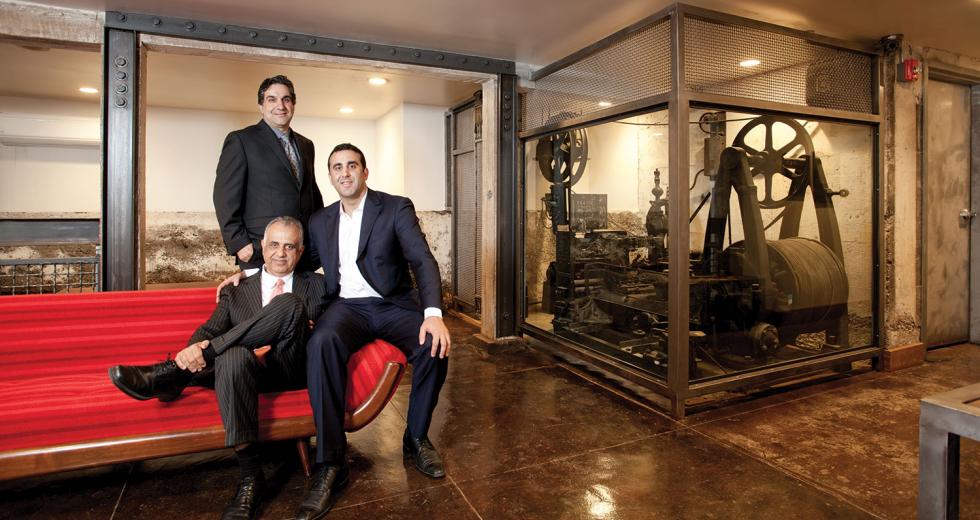Three years ago a wrecking ball known as the subprime mortgage meltdown slammed into Sacramento’s real estate market, kicking up a dust cloud over the city’s urban development plans. But rather than dwell on the financial obscurity of the future, David Miry and Steve Lebastchi kept their eyes on the past.
When the recession was turning up-and-coming developments into ghost towns, the duo was in the middle of a slew of new projects that could’ve collapsed in their faces. But as founders of D&S Development Inc. — one the region’s leading real estate owners, developers and operators — Miry and Lebastchi have built their reputation on a shared appreciation for history. The credit crunch kept many Sacramento developers locked in limbo, but D&S kept doing what it had been doing for years: Pumping new life into aging, forsaken structures in the heart of the city and beyond.
As a result, old has become the new new. D&S Development renovated a historic inn built in 1913 to serve miners and shepherds. They converted Old Sacramento’s historic Mechanics Exchange building into the riverfront’s first luxury loft development. They gave a $4.2 million makeover to the decrepit bakery warehouse on 14th and R streets. The 22,000-square-foot building was nothing but a forlorn waste of space next to Randy Paragary’s Cafe Bernardo, R15 and Empire nightclub complex. But the company had an idea for a mixed-use project with 12 high-end lofts on the upper level and five retail spaces on the ground floor.
Now, on any given night, midtown’s R Street Corridor crackles with energy. Urban professionals swarm the Shady Lady Saloon, Top This yogurt shop, Magpie Caterers Market & Café and Burgers and Brew. Upstairs, the lofts are sold out. They range in size from 500 to 1,000 square feet and come furnished with imported tile, stainless steel appliances and natural granite. The interior blend of brick, iron and recycled wood creates the balance of history and modern luxury that D&S thrives on.
“D&S came in and brought local entrepreneurs and local businesses and worked with them on design, financing and leases and created a project that was deeply Sacramento,” says Todd Leon, R Street development manager for the Capitol Area Development Authority. “They laid down the foundation for R Street heading into the next decade.”
In 2009, the Sacramento Business Journal hailed the 14th and R project as the “Best Project of the Year.” The success of this project helped convince the city that this company could take on a section of K Street, one of Sacramento’s most blighted strips. At the moment, D&S (in partnership with CFY Development Inc., a multi-family housing developer) is in the design stages of its plan to restore the 700 block of K Street with a mix of historic rehab, new shops, entertainment and affordable apartments. If everything runs smoothly, the project will be completed by 2014.
But for Miry, 60, and Lebastchi, 49, turning eyesores into urban hot spots wasn’t always the plan. The two met in the 1980s at the University of San Francisco. They found common ground in their place of origin (Iran), field of interest (structural engineering) and job prospects: “When we came here, we were starting from scratch,” Lebastchi says. “We had nothing. It was hard to find a job in those years.”
And they were too restless to be confined to a cubicle. “I couldn’t work in offices,” Miry says, “because I couldn’t sit behind a desk for eight hours.”
With MBAs in their back pockets, they opened Subway franchises, Miry in Sacramento and Lebastchi in San Jose. Business started booming, and they went on to open other franchises for companies including Superb Burger and others in various states. They did all the construction for their branches, and it was obvious they preferred the hands-on work. By the mid-1990s, the entrepreneurs set their sights on real estate.
Since inception, D&S has managed a diverse portfolio of assets that includes numerous commercial properties, each one different than the last. Around town they’re known as unconventional developers who stay on schedule, follow through and take chances on properties that nobody else pays attention to. They work fast to keep costs down and make connections with local retailers who have a personal stake in the River City. They target buildings with “a lot of character,” Lebastchi says, and feel rewarded when one of their revived structures stimulates the surrounding community.
And their sense of nostalgia seems to be contagious — at least at the corner of R and 14th, where Shady Lady founders used the space to create a 1920s jazz lounge. “We considered tons of spots, but this seemed to be the best fit for us,” says saloon co-owner Garrett Van Vleck. “You kind of have to make your theme and style fit the building. Our 1920s theme wouldn’t have worked in a modern loft lobby, but the old brick allowed it to work perfectly.”
Don’t think for a minute that they didn’t feel the effects of the recession. But as the market plummeted, they stuck to fundamentals by choosing projects that make financial sense and by going above and beyond to attract tenants. According to Miry, D&S started furnishing the lofts, which the company didn’t have to do before. These types of decisions prove they understand how to be flexible with the market, says Tom Kigar, development services director for the Capitol Area Development Authority.
“They have a real knack for being able to invest enough in their projects so the value is obvious to the buyer or renter,” Kigar says. “They have an innate sense of what works.”
But the city’s financing problems haven’t gone away. At the moment, redevelopment agencies are in a legal battle with the state that is trying to eliminate them. Gov. Jerry Brown already signed the death warrant for redevelopment agencies with the new state budget in June. Redevelopment agencies pump a large amount of an area’s property tax revenue into local projects, but the state wants to redirect the money toward public services. According to the Assembly bills (ABX1 26 and 27), their only chance of survival would be for cities and counties to pay the state their shares of $1.7 billion.
In response, the California Redevelopment Association, the League of California Cities and others sued the state, claiming the statutes are unconstitutional and violate Proposition 22, which prevents lawmakers from treating local tax coffers like a grab bag. It’s in the hands of the California Supreme Court now. But rather than wait around, the Sacramento Redevelopment Agency recently chose to opt in and make the payments to remain in business. Sacramento owes about $22 million.
“We decided to make the payments because redevelopment is critical to Sacramento’s economic survival and we were determined to cobble together the funds to try and save it,” says La Shelle Dozier, executive director of Sacramento Housing and Redevelopment Agency, in a statement.
For now, only certain projects approved before the governor signed the budget can move forward. And no new action or changes in contracts can be made on those approved projects. But in the meantime, the city will continue its commitment to invest in economic development and help streamline the permitting process, says Leslie Fritzsche, Sacramento’s downtown development manager. And even though financing is hard to come by, she adds, D&S represents the type of company that knows how to seize valuable opportunities in shaky financial times.
“They’re willing to take on the hard projects, and they do it with style,” Fritzsche says. “We have a wonderful array of historic properties in Sacramento. Their group is able to use those properties and bring them into the new century, combining the best of the old with the new.”
The city has partnered with D&S on two projects to date, the restoration of the 90-plus-year-old Maydestone Apartments and the 700 Block K Street project. With the city committed to spurring urban development, this public-private partnership could be the financing model of the future. In any case, the developers at D&S say they don’t take anything for granted. “It’s a tough market,” Miry says. “You don’t know who’s going to be in business next year.”
But if history is any indication, D&S will be around for a while, building upon their successes with more transformative projects that make an impact.
“To do the types of projects they’ve done in this economy really is a testament to their vision and capabilities as developers more than anything else,” says Ali Youssefi, vice president at CFY Development. “They’ve taken buildings that have been in severely deteriorating conditions and turned them into jewels in downtown Sacramento.”
Recommended For You

Fresh Fruit
A Sacramento landmark is ripe for revitalization
With ground set to break on an entertainment and sports complex said to include state-of-the-art technology, owners of Downtown Plaza’s next-door neighbor, the California Fruit Building, have a high-tech makeover plan of their own.

Arts & Aesthetics
Fine art collections serve as on-site museums for some of Sacramento’s culture-loving companies.



